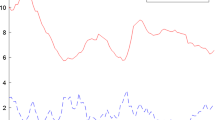Abstract
Time-series analysis of weekly initial claims over 1967–2012 reveal the following: (1) Initial claims are highly seasonal and cyclical, but do not follow a specific trend. Seasonality follows a “W” pattern over the 52 week period. (2) Initial claims are subject to conditional volatility and volatility clustering. The EGARCH and CGARCH specifications provide reasonable representations of the conditional volatility. The former suggests the existence of asymmetries in conditional variance. The latter implies that both permanent and transitory shocks affect volatility, but the effect of permanent shocks is more pronounced. (3) Both models perform well in terms of forecasting as well as within- and out-of-sample model selection criteria.





Similar content being viewed by others
Notes
The specification of seasonal differencing with weekly data creates a challenge as the number of weeks varies between 52 and 53 weeks over time. We settle on a 52-week differencing.
References
Bellerslev, T. (1986). Generalized autoregressive conditional heteroskedasticity. Journal of Econometrics, 31, 307–327.
Beveridge, S., & Nelson, C. R. (1981). A new approach to decomposition of economic time series into permanent and transitory components with particular attention to measurement of the business cycle. Journal of Monetary Economics, 7, 151–174.
Cubadda, G. (2007). A reduced rank regression approach to coincident and leading indexes building. Oxford Bulletin of Economics and Statistics, 69(2), 271–292.
Ding, Z., Granger, C. W. J., & Engle, R. F. (1993). A long memory property of stock market returns and a new model. Journal of Empirical Finance, 1(1), 83–106.
Engle, R. (2001). GARCH 101: The use of ARCH/GARCH models in applied econometrics. Journal of Economic Perspective, 15, 157–168.
Engle, R.F., Lee, G.G.J. (1999). A permanent and transitory model of stock return volatility. In R. Engle and H. White, (Ed.): Conintegration, Causality and Forecasting, a festschrift in honor of Clive W.J. Granger (Oxford University press).
Gavin, W.T., Kliesen, K.L. (2002). Unemployment insurance claims and economic activity. Federal Reserve Bank of St. Louis Review, 15–27.
Kliesen, K. L., & Wheelock, D. C. (2012). How well do initial claims forecast employment growth over the business cycle and over time? Federal Reserve Bank of St. Louis, Economic Synopses, 7, 1–6.
McConnell, M. M. (1988). Rethinking the value of initial claims as a forecasting tool. Federal Reserve Bank of New York, Current Issues in Economics and Finance, 4, 1–2.
Montgomery, A. L., Zarnowitz, V., Tsay, R. S., & Tiao, G. C. (1998). Forecasting the U.S. unemployment rate. Journal of the American Statistical Association, 93(442), 478–493.
Nelson, D. B. (1991). Conditional heteroskedasticity in asset returns: a new approach. Econometrica, 59, 347–370.
Nicholson, W., & Needels, K. (2006). Unemployment insurance: strengthening the relationship between theory and policy. Journal of Economic Perspective, 20, 47–70.
Stock, J. H., Watson, M. W. (1990). Business cycle properties of selected U.S. economic time series, 1959–1988. National Bureau of Economic Research, NBER Working Paper Series
Stock, J. H., Watson, M. W. (1998). Business cycle fluctuations in U.S. macroeconomic time series. National Bureau of Economic Research, NBER Working Paper Series
Wei, C. C. (2009). Using the component GARCH modeling and forecasting method to determine the effect of unexpected exchange rate mean and volatility spillover on stock markets. International Research Journal of Finance and Economics, 23, 62–74.
Author information
Authors and Affiliations
Corresponding author
Additional information
The authors acknowledge financial assistance from the Workforce Data Integration and Analysis (WDIA) project at Illinois State University. Helpful suggestions were provided by session participants at the 2012 meetings of the International Atlantic Economic Society in Montreal. We also thank an anonymous referee for valuable insights and suggestions.
Rights and permissions
About this article
Cite this article
Mohammadi, H., Rich, D.P. Dynamics of Unemployment Insurance Claims: An Application of ARIMA-GARCH Models. Atl Econ J 41, 413–425 (2013). https://doi.org/10.1007/s11293-013-9393-z
Published:
Issue Date:
DOI: https://doi.org/10.1007/s11293-013-9393-z




